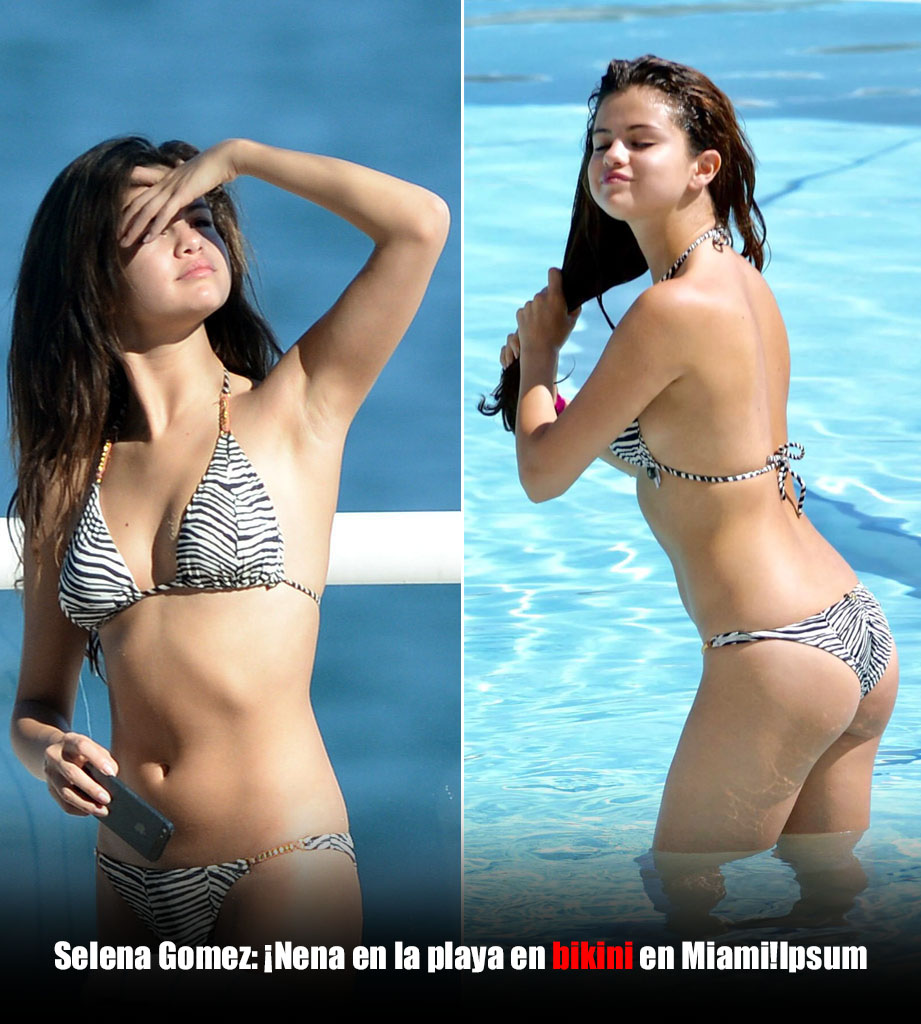Karahan Tepe, located close to its better known relative Göbekli Tepe in southeast Turkey, was first acknowledged in 1997 but remained unexcavated until 2019. Both sites, including several others, are today identified as Taş Tepeler (meaning “stone hills”) archaeological sites. These Taş Tepeler sites typically border the Harran Plain on semi-mountainous escarpments and reflect early Neolithic phases of building.
Understanding Karahan Tepe in the Context of Taş Tepeler
Unlike the majority of known Taş Tepelers, Karahan Tepe has yielded a large building which compares in size to the larger monumental enclosures of Göbekli Tepe . This circular space, named Str. AD, is understood to reflect late Pre-Pottery Neolithic PPN A to early PPN B construction, c.9000 to 8800 BC.
- Decoding Göbekli Tepe: Secret Society AND Space Observatory?
- The Forgotten Stones of Karahan Tepe, Turkey
Compared to Göbekli Tepe , the megalithic features of Str. AD, along with the rest of the site, have not preserved as well. Nevertheless, the enclosure formed a major hub of ritual activity at the site. It also led to a remarkable space located at the northwest which has been named Str. AB. Str. AB is a rounded hollow built entirely out of the bedrock and at present is a singular feature of Taş Tepeler sites.

Top; Str. AD at Karahan Tepe from the southeast (author), Bottom; solstice rising and settings relative to Str. AD. (adapted from Karul 2021)
The apparent entrance to its interior was via a small descending stairwell of piled slabs located at the northwest of Str. AD. Inside Str. AB’s chamber which, together with Str. AD, likely witnessed roofing, are 10 phallic-shape structures carved out of the bedrock lending the interior a random stalagmited appearance.
A further structure, resembling beasts depicted upright from other Taş Tepelers was carved and inserted into the floor. Relative to the entrance, the standing beast would have confronted those who entered.
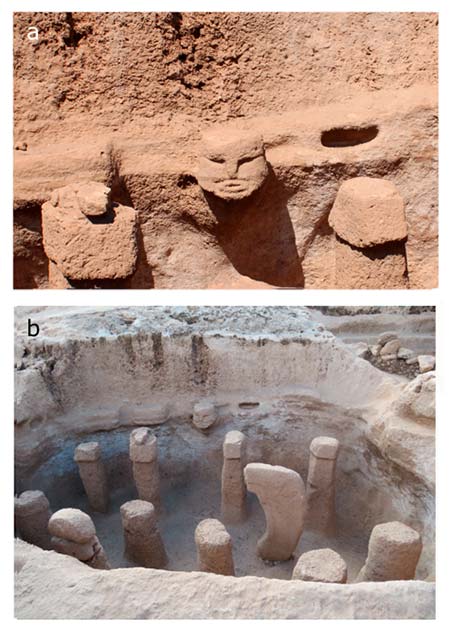
Str. AB profile (author); (b) Str. AB in full. (Martin Sweatman)
The Carved Human Head Unearthed at Karahan Tepe
A highly imaginative feature of Str. AB is a human head carved out of bedrock emerging from its western wall which the site’s excavator believes people were paraded in front of (Karul 2021, 25). The apparent exit leading out of Str. AB, formed by a pile of slab steps, lay opposite its entrance.
Above this is a serpentine channel cut into the rock which might have carried water possibly indicating that ritual washing concluded the proceeds that transpired in the chamber; events likely augmented by archaeoacoustics of its sound conducive interior.
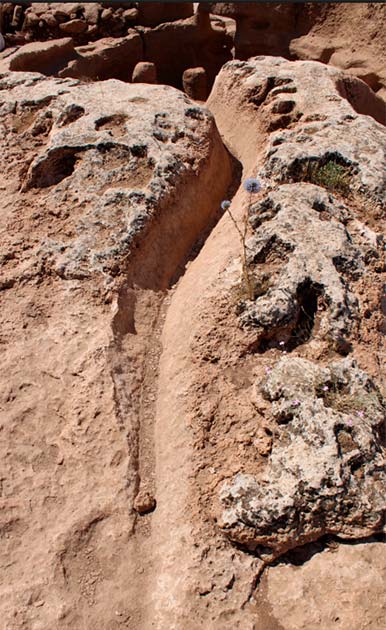
Serpentine channel at Karahan Tepe. (Alistair Coombs)
It is notable how Str. AB captures the Neolithic innovation of constructing subterranean ritual spaces that simulate natural environments such as grottos and caves, contrasting the Palaeolithic appropriation of those natural environments.
In this instance the head emerging from the western wall of Str. AB at Karahan Tepe develops a concrete materialisation of the masks and spirit animals Palaeolithic artists unleashed from cave walls by manipulating fissures with lines and paint.
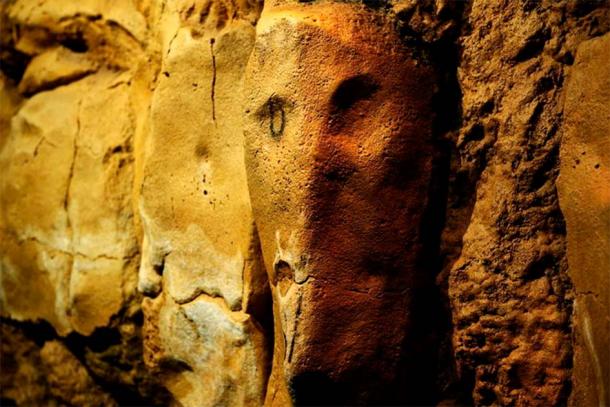
Grotesque mask, Cave of Altamira. (Pedro Saura)
On this theme, Str. AB’s truncated head which compares with other humanoid heads from Taş Tepeler statuary, resembles a masked ancestor emerging from the rock or spiritual membrane. Miniature mask carvings made of stone and bone believed to mimic life-size masks not present in the record along with life-size stone heads thought to depict people wearing headgear, have been noted at Göbekli Tepe and the same examples are numerous at Karahan Tepe and the Neolithic elsewhere.
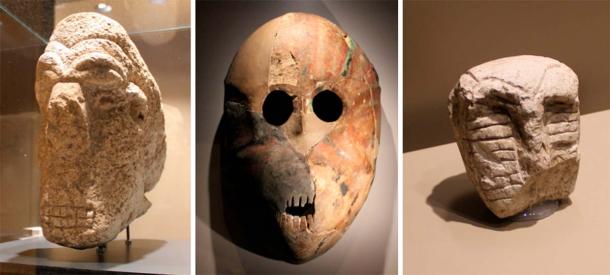
Left to Right: Life-size head from Karahan Tepe, Miniature from Karahan Tepe, Life-size mask from Nahal Hemar. (Alistair Coombs)
The use of costume, the character of which clearly drove at evoking the strange and frightful, distinguishes the gatherings at these sites as special social events more than random mergers and that considerable organisation was involved in planning them at prearranged times of the year. Acknowledgement of solstices, their symbolism, religious ideas and ceremonies has been proposed at the Palaeolithic, Neolithic Jericho and Taş Tepelers. Later calendar-based festivals of Mesopotamia describe these points of the year in contrasting hues as key times when gods, ancestors or destructive forces return to the living. With those nuances in view, it might be relevant that the head of Str. AB faces the summer solstice sunrise.
Ceremonial Events in Karahan Tepe’s Underworld?
The semi-subterranean design of Taş Tepelers and brief labyrinthine experience of descent to their interiors provided is again notable against the use of restricted spaces in cave environments of Palaeolithic eras.
Thought of as “thresholds” or “underworlds” full of spirits and forces dangerous to normal people, the inner recesses of caves are suggested to have hosted secret society initiation and ceremonial events of socially complex hunter-gatherer groups so therefore provide an interesting backdrop to the built Taş Tepeler spaces.
Summarily, it had been tentatively considered that Str. AB engaged the cosmological underworld content of Göbekli Tepe’s Pillar 43 to a more virtual or interactive level. Symbolic elements recently excavated from corresponding ritual spaces at Karahan Tepe and at Göbekli Tepe’s Enclosure D support this premise. Firstly, is a life-size boar statue found at the northern end of Enclosure D, behind Pillar 43.

Life-size boar statue found at the northern end of Göbekli Tepe’s Enclosure D. (Turkish Ministry of Culture)
The statue was painted in red, white and black and was found upon a pedestal bearing an H symbol, a crescent, two snakes and perhaps three mask impressions. Similar to the image and statuary of standing beasts known from Pillar 43, Str. AB and elsewhere, the boar was likely revered in that specific form as a fearsome underworld guardian.
- The Vulture Stone of Gobekli Tepe: The World’s First Pictogram?
- Taş Tepeler: Anatolia’s Land Of Great Transformation
Secondly, from a parallel ritual space excavated at Karahan Tepe a small vulture sculpture was found. In front of the vulture were stone plates, items similarly discovered in front of a small boar statue at Göbekli Tepe’s Enclosure C (does Pillar 43 depict such a plate?). Adjacent to the vulture was a larger seated male statue fixed to the ground.

The standing man unearthed at Karahan Tepe. ( The Ministry of Culture and Tourism )
The figure has emphasised ribs and shoulder bones as if his condition was one of partial skeletonisation and near death, like other human depictions from the site. Animal images are shown in the same way which have been read as expressing increased ferocity from famishment rather than death.

Left; Standing boar inserted into ground (author), Right; Pillar 43 detail. (Author provided)
This likely held for the standing boar, a larger outline of which occupies Str. AB. However, the newly discovered man is elated which seems to tilt interpretation towards signifying mystic death or existence post-mortem aligned to other Taş Tepeler images including Pillar 43. This assemblage links a constellation of belief expected to be contributed to as the record widens.
Top image: Standing man from Karahan Tepe. Source: Turkish Ministry of Culture
By Alistair Coombs


